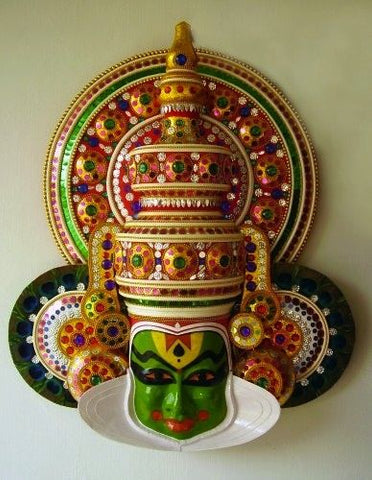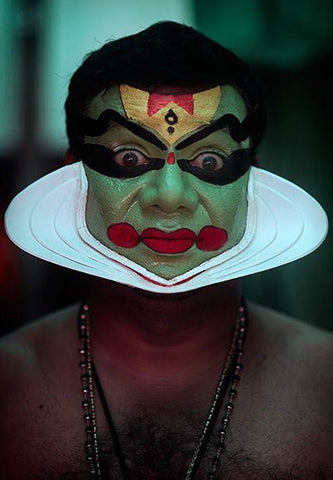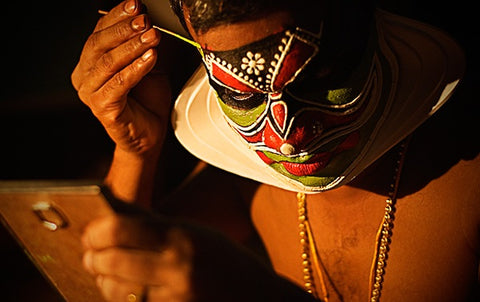Kathakali and India have been intertwined for decades. The exotic Kathakali dance is not only about the dance; its dresses and masks play a crucial role in its prominence on the international stage. The iconic Kathakali face masks sit at the heart of Kathakali dance.
The attire essential during Kathakali dance performances is so unique that even the Indian Ministry of Culture and Sangeet Natak Academy have recognised it among the top Indian classical art forms.
The Kathakali dance of Kerala is more like a way of enacting stories. This dance form also takes inspiration from martial arts techniques. So it’s safe to say that it’s a kind of dance form that carries a piece of history with it. One can even find its mention in the prominent ‘Natya Shastra’ by Bharat Muni.
So let’s dive deep into the fascinating world of Kerala Kathakali face, and its significance in the realm of Indian craft and performance art.

What is Kathakali Face Mask Art?
Let’s begin the discussion by unraveling Kathakali's meaning. ‘Katha’ means stories whereas ‘kali’ means play. So in simple terms, we can say that Kathakali dance narrates stories through plays/dance.
Don’t make the mistake of assuming the Kathakali face mask is just a mere costume; it's a part of the complete dance form that’s associated with India’s centuries-old tradition and craftsmanship. These masks are not just random masks that we always associate them with. The Kathakali mask features elaborate designs and exotic colours to make it truly a part of the performance. It plays a pivotal role in bringing characters to life on the Kathakali stage. Each mask enlivens the character it represents. The characters can be anything from divine beings to mythical creatures which portray complex emotions and narratives.

The Story Behind the Kathakali Face Masks
Delving into the history and mythology that surrounds Kathakali dance lets you truly appreciate the significance of Kathakali face masks. Legend has it that the origins of Kathakali can be traced back to the ancient Sanskrit texts and the classical dance-drama forms of southern India. As the dance form evolved, so did the masks. It’s evolved from simple facial adornments to intricate works of art that define the characters of Kathakali.
The journey of Kathakali face masks begins with masks and ends with Kathakali face painting. It’s always been intertwined with the rich cultural heritage of Kerala, where artisans dedicated their lives to master the craft. Passed down through generations, the art of Kathakali mask-making became more than just a skill; it has become a symbol of stories people in Kerala believe or their celebrations and traditions.
The Kathakali mask that is entirely green represents the noble people whereas the masks with red bears are signs of individuals with demonic souls. Following the same narratives, masks with black beards are signs of cavemen whereas the ones with white beards are fantastic souls.

Process of Making Kathakali Masks: A Labor of Love
The creation of a Kathakali mask is a long, step-by-step process that demands patience, precision, and a deep understanding of the art form. It begins with the selection of the base material of the Kathakali mask. Most masks are made of paper mache, wood, plaster of Paris, or clay. So the masks are pretty sturdy and work as the canvas for the artisan's imagination. With delicate strokes and raveled detailing, the artisan brings the character to life, layering colours and textures to seize its essence.
From the initial sketches to the final touches, every step in the process is imbued with meaning and intention. Each mask is not just a piece of art but a manifestation of the character's personality, emotions, and traits. It is this attention to detail and craftsmanship that elevates Kathakali masks from mere props to powerful symbols of cultural identity and artistic expression.

Journey of Kathakali Mask Handicrafts to Dance
The journey of Kathakali masks does not end with their creation as they are created to be a part of an on-stage performance. They only get to convey symbols and stories when skilled Kathakali performers put them on. The beautifully adorned dancers in elaborate costumes and mesmerising masks breathe life into the characters they portray, transporting audiences to a world of myth and magic.
The relationship between Kathakali masks and dance is symbiotic - each complements the other in a stunning display of art, crafts and storytelling. Kathakali dance is not kathakali dance without Kerala kathakali face masks. In the same way, the Kathakali masks or Kathakali face painting holds no value if the dance is not performed at its finest. Both depend on each other to reflect the stories through plays.
As the dancers move and emote, the masks become parts of their personas, amplifying their expressions and taking their performances to a new height. Together, they narrate stories that keep the audience engaged and mesmerised.
As you are now well aware of Kathakali mask making, its history, the significance of Kathakali mask painting and how it’s a part of India’s cultural heritage, Kathakali masks stand out for the artistic excellence that goes into them. From their humble beginnings as handmade handicrafts to their starring roles on the Kathakali stage, these masks embody the spirit of creativity, dedication, and passion that defines Indian craftsmanship.
As we marvel at the beauty and intricacy of Kathakali masks, let us not forget the artisans who labour tirelessly to keep this ancient tradition alive. They make the masks the epitome of eloquence and elegance. Nothing appears as graceful as Kathakali face masks when the dancers merge themselves with the art.
If you are a fan of Indian crafts, there’s no shortage of impressive decor or regular essential handmade products inspired by Indian art and cultural heritage in iTokri. Browse through our collection to celebrate the beauty of Indian craftsmanship and support the artisans who keep our traditions alive for generations to come.
 Verified Purchase
Verified Purchase








Leave a comment (all fields required)